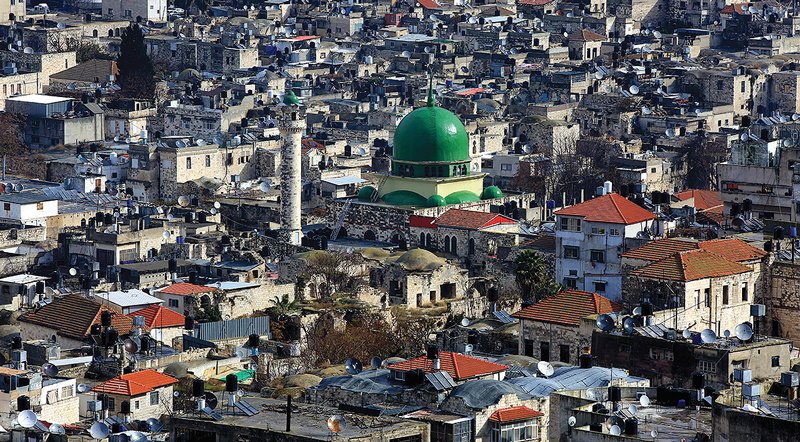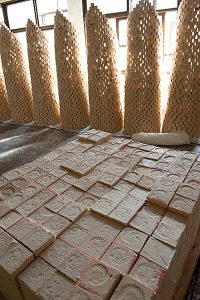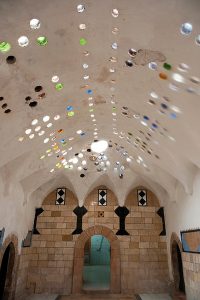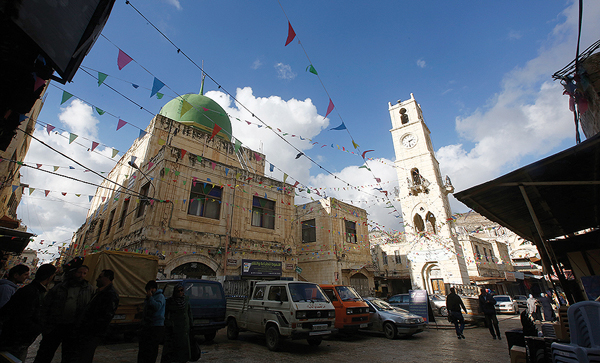
Nestled in the valley between Mount Ebal, rising 940 meters above sea level, and Mount Gerizim, at 840 meters, lies Nablus, a Palestinian commercial and cultural hub. Its story is not only that of a city but also of the people who have lived in and around it; a story that spans changes in belief, religion, and customs, leaving behind a wealth of archaeological evidence that speaks to us even today.
Archaeological remains of early settlement that dates back to the Bronze Age indicate that the Nablus area was first inhabited in the third millennium BC, during the Canaanite period. The first people to inhabit the site named this area Shechem, as it appeared in the ancient Egyptian historical sources. It is identified today with Tal Balātah, an archaeological site to the east of the city. It was a major Canaanite urban center during the second and first millennia BC.
The newer part of the city of Nablus was first built during the Roman era in 71 AD. It was named Flavia Neapolis; Neapolis, New City, and Flavia in honor of the emperor Flavius and his family. Neapolis was built west of the original Canaanite city, in the present location of today’s Old City.

Under Constantine, the first Christian emperor, the persecution of Christians in the Roman Empire ceased (313 AD). During Justinian’s rule (527–565 AD), five churches were built simultaneously. Jacob’s Well (Genesis 29: 1–10; John 4:5–30) is found in the eastern part of the city; the church on this site was built by St. Helena, the mother of Emperor Constantine, in 327 AD. Most of the church was destroyed in 1572, and work on the present church – begun by Safreus in 1908 – was interrupted by the start of the World War I in 1914.
The Crusader era began when the Crusaders occupied Jerusalem in the spring of 1099. On July 25, 1099, Nablus was finally freed from the Crusaders by the victory of Salāh ad-Dīn al-Ayyūbi’s forces. Later the Mamluks ruled the area for the next 256 years. The Ottomans took over Nablus in 1521, depending initially on the local Mamluk governors as allies. Afterwards Nablus came under complete Ottoman rule, and Sultan Abd al-Hamīd I came to power, followed by his son Abd al-Hamīd II who ruled from 1876 to 1909.
The Old City
Traditional buildings are designed to adapt to the topography and climate of the site. Courtyards allow airflow in summer and reduce heat; they are not a static structural element separate from their social environment. The traditional building is organic, social, environmental, and harmonious in its size, proportions, and relationship to surrounding structures. It is created by the architectural hand to suit the needs of its users, within the framework of local customs and traditions.
The old market of Nablus reveals its Oriental character that takes into account the sociability of commercial dealing within its specialized markets. It is considered one of the most beautiful examples of this organizational type. Nablus trade extended to several locations and reached Egypt, ash-Shām, al-Hijaz, and Mount Lebanon. The planning of the old and new khān market halls, which are located in the center of the old market, are a distinct example of a traditional oriental style of engineering that is characterized by uniformity and equality in the shapes of the various frontages of shops and the penetration of natural light.
The Caravanserai
A caravanserai is a building designed to welcome visiting merchants. The western caravanserai is one of the most important historical buildings inside the Old City and is located at the western end of the blacksmiths’ market.
Its soap is fragrant and brilliant
Like musk in scent and snow in purity.
It survived thousands of years, yet
It still wipes out dirt and renders bodies tender.
(excerpt from Mohammad al-’Amad’s poem “Ibn al-Madinah”)
Soap manufacturing in Nablus was a major factor in the development of local commercial activity and trade between provinces. For centuries the city’s soap manufacture played a significant economic role in Palestine. Nablus was the center of the industry, and at one time counted more than 34 functioning soap factories. The Arafat Soap Factory in the Old City has been renovated to make it suitable for use as a multi-purpose cultural center.
♦ Palestinian Dishes
› Kanafeh
The word kanafeh (كنافة) is from the Circassian words chinna (bulbul) and pha (color), meaning the color of the bulbul bird.
Kanafeh in Arabic, which means “to shelter,” is generally believed to have originated in the Palestinian city of Nablus. It is made with semolina dough (smeed), a filling of sweet white cheese, red food coloring, and melted butter. Many people prefer to use ghee (samneh) instead of butter. The kanafeh is then baked to a golden brown and drizzled with a syrup made from sugar, honey, and a few drops of rosewater or orange blossom water.
Mozzarella cheese can be used as a substitute. Crushed pistachios are sprinkled on top as a garnish. In Nablus, kanafeh is stuffed into pita bread and eaten for breakfast. Kanafeh can be filled with chopped walnuts instead of white cheese.
Christians of Nablus
Nabulsi society is characterized by the presence of a number of non-Muslim religious traditions whose members have lived in the city throughout its history. Religious tolerance and coexistence among the sects are one of the city’s most prominent features. This diversity forms an integral part of Nabulsi society, a tie that binds its members through social relationships that are, for the most part, cordial and appreciative, despite differences of religion and sect.
The Samaritans
The present-day Samaritan population in Nablus does not exceed 387 persons, and there are 368 others who live in the city of Hūlūn, which is near Yāzūr Village on the Mediterranean coast. Samaritans are the descendants of Jacob Ibn Ishāq Ibn Ibrahīm (the Jacob of the Old Testament), and Mūsa Ibn ‘Imrān (Moses) is their prophet. They claim kinship to the ancient Israelites and believe “The name Israel is an adjective of our master Jacob, and the meaning of Israel is ‘the power of right.’” “There is neither a Samaritan religion nor a Jewish religion; the religion is Israeli. The name Samaritan returns to the time of Dāwūd and his son Sulaymān (the Biblical kings David and Solomon), since there was dissent between Dāwūd, the king, and the chief priest because the latter refused to build a temple in Jerusalem and his followers were called Shumrīm, which means in Arabic the conservators, that is, those who conserve their old traditions and refuse to build a temple in Jerusalem.”
Historical Mosques
Nablus mosques are among the most important historical buildings still in use in the city today. The buildings themselves show much evidence of reconstruction and re-use, notwithstanding the continuity of their original religious function, which changed according to the change of religion in the city over the years. There are ten historic mosques within the boundaries of the Old City. An-Naser Mosque in the center of the Old City is a landmark.
Religious Shrines, Tombs, and Zāwaiyah
Many religious scholars and Sufis visited Nablus, especially during the Mamluk era, and some of their biographies and contributions to Islamic thought throughout history have been recorded.
Tombs were erected for these pious men, some of whom were buried in the rooms where they had lived. These sites later became shrines, cared for by faithful local people who often placed candles in the windows and left votive offerings.
Public Baths

Establishing public baths, (hammām, plural hammāmat) in Nablus, as in other Islamic cities, was linked to religious needs, social customs, and traditions. They served not only the need for cleanliness and hygiene but also provided a forum for community life and leisure for both men and women. Hammāms number among the architectural treasures of old Nablus. The baths are found in both commercial and residential areas. Ten different baths were built in the Old City at various times.
Holistic engineering design had to be employed in the construction of the baths since preserving a high internal temperature was naturally a priority. This was achieved by devices such as doors that sealed off passageways at each end, good ventilation through holes in the roof, and natural lighting by means of round glass roof lights.
♦ Palestinian Dresses
› Rafidia Dress
White linen fabric with red and green stripes distinguishes the traditional dress found in Rafidia. The embroidery on the chest panel and sides is minimal, but the chest panel is decorated with colorful silk pieces (tashareef).
‹ Photo courtesy of ©MahaSaca, Palestinian Heritage Center, Bethlehem, Palestine.
Residential Buildings in the Old City
Residential structures form the majority of buildings inside the Old City (more than 50 percent). Each has its own distinctive characteristics, whether size, ornamentation, or the social habits of the inhabitants. The most distinctive features of the buildings in the Old City consist of a harmony in the architectural masses and the streamlining of their structures, which make them very beautiful.

The layout of Nablus’ residential buildings is random, without geometrical order or straight vertical and horizontal lines. Buildings follow and adapt themselves to the shape of the land they lie on. In a domino effect, the organic growth and haphazard layout of one building affect those abutting it, so that the entire layout of parts of the city can be seen as extending and growing as the social and demographic needs of the inhabitants dictate, rather than according to any predetermined plan.
» Naseer R. Arafat is an architect and development and planning specialist who has an in-depth knowledge of conservation theory and practice. He has participated in a number of local and international courses and workshops related to sustainable development, planning, and cultural heritage. He has assisted with a number of projects, mainly the National Register of Historic Buildings in Palestine and Saudi Arabia. Mr. Arafat is the author of Nablus, City of Civilizations.


